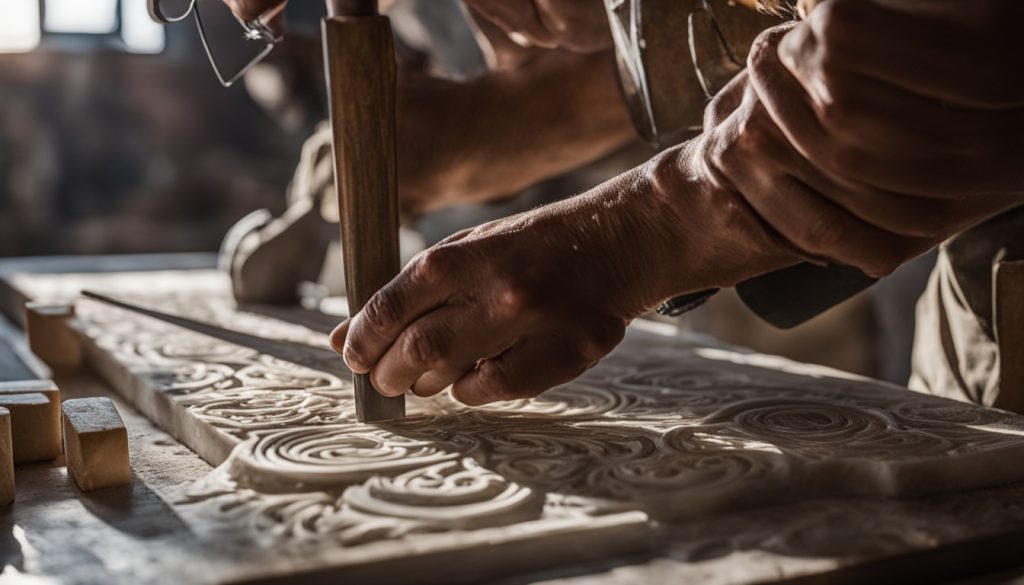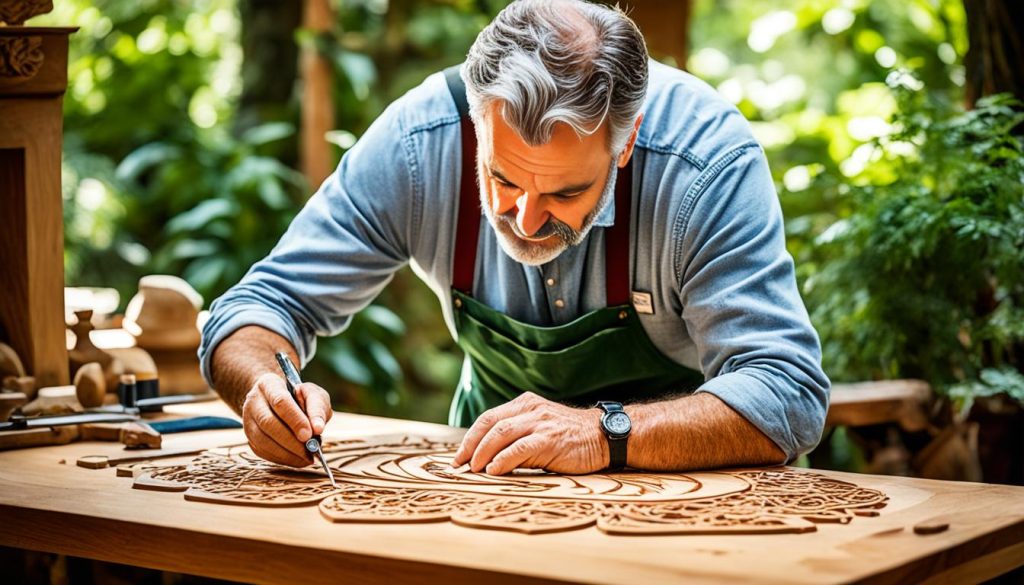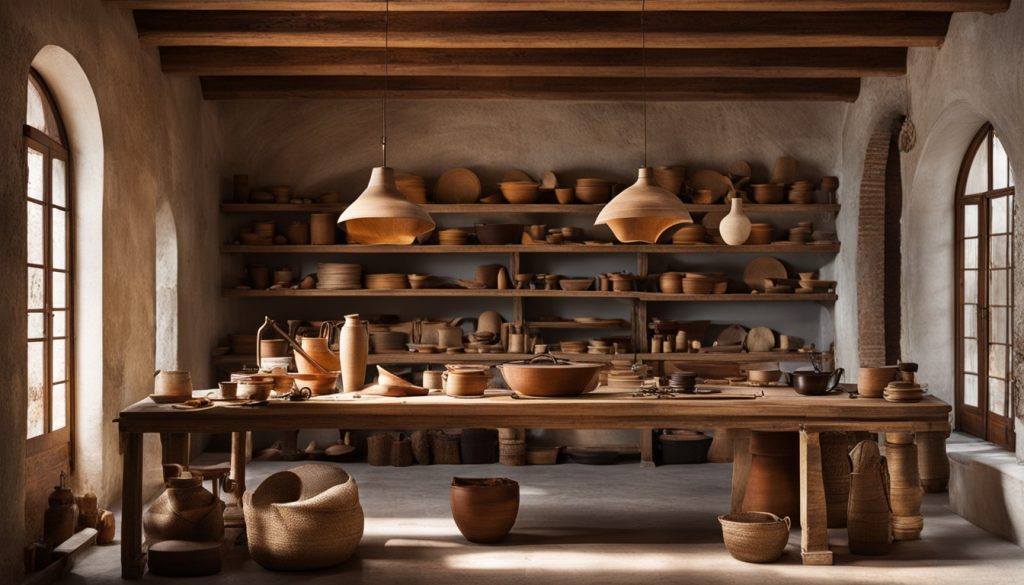Italy is famous for its deep craftsmanship heritage. This tradition has lasted for centuries. It shows in the beautiful Murano glass and the fine Florentine leather goods. Italian craftsmanship is known for its skill and precision.
This section will take you into the world of Italian craftsmanship. We’ll look at its history, traditional techniques, and how it affects fashion and design. We’ll also talk about how they keep this heritage alive and its impact today.
Come with us as we explore the heart of Italy’s artisan mastery. See how it inspires people all over the world.
Key Takeaways:
- Italy boasts a profound heritage in craftsmanship, characterized by artisan mastery.
- Murano glass and Florentine leather are iconic examples of Italian craftsmanship.
- Italian craftsmanship has played a significant role in fashion and design.
- Efforts are being made to preserve Italy’s craftsmanship heritage.
- Italian craftsmanship continues to inspire creatives globally.
The Rich History of Italian Craftsmanship
Italian craftsmanship has a long history, making it a key part of Italy’s culture. It ranges from Renaissance art to luxury fashion, showing Italy’s unmatched skill and detail.
It started in ancient times with artisans perfecting ceramics, metalwork, and textiles. The work of ancient Roman craftsmen still affects Italian design and architecture today.
In the Renaissance, Italian craftsmen made beautiful art and furniture that people around the world admire. Their work combined creativity with technical skill, defining Italian craftsmanship. Artists like Leonardo da Vinci and Michelangelo were not just painters and sculptors but also skilled craftsmen.
Italian craftsmen also excelled in glassmaking, jewelry, and leatherwork. The famous Murano glass and Florentine leather goods show their exceptional skill.
Over time, Italian craftsmanship has kept evolving, adapting to new trends and technologies while holding onto its traditions. It’s known for excellence, making Italian products stand out in fashion, design, and luxury goods.
Today, Italian craftsmanship is celebrated worldwide for its unmatched quality and detail. Artisans use old techniques to make modern pieces that mix tradition with innovation.
The next section will explore traditional Italian craftsmanship techniques. It will show the unique skills and expertise of Italian artisans.
Traditional Italian Craftsmanship Techniques
Italy is famous for its traditional craftsmanship, passed down through generations. Skilled artisans have perfected these techniques over time. They focus on details and keep these old methods alive.
In furniture making, Italy stands out. Artisans use marquetry to create beautiful designs. They cut and fit veneer pieces together with great precision and creativity. This results in furniture that’s both useful and a piece of art.
Italian textiles are also renowned for their luxury. Artisans use techniques like jacquard weaving and hand embroidery. These methods show their skill and artistry in textiles.
Italian leatherworking is another area where tradition is celebrated. Techniques like vegetable tanning make the leather soft and strong. This method is good for the environment too.
Italian Pottery: A Fusion of Tradition and Innovation
Italian pottery combines old techniques with new ideas. Artisans in places like Sicily and Umbria use hand-painting and glazes. Each piece shows their skill and honors Italy’s ceramic history.
By keeping these techniques alive, artisans keep Italy’s culture going. Their hard work and creativity show the love they have for their craft.
| Traditional Italian Craftsmanship Techniques | Examples |
|---|---|
| Woodworking | Marquetry, Inlay |
| Textiles | Jacquard Weaving, Hand Embroidery |
| Leatherworking | Vegetable Tanning, Hand Stitching |
| Pottery | Hand-painting, Glaze Application |
Iconic Italian Craftsmanship: From Murano Glass to Florentine Leather
![]()
Italy is famous for its legendary craftsmanship around the world. This section looks at iconic examples like Murano glass and Florentine leather. These have amazed art lovers and experts for centuries.
Murano Glass: A Kaleidoscope of Beauty
Murano glass comes from the island of Murano near Venice. It’s known for its beautiful glasswork. Artisans there have been perfecting their skills for years, making stunning glass pieces.
They blend tradition with new ideas. Each piece, from glassware to chandeliers, is full of vibrant colors and details. Murano glass shows off Italy’s craftsmanship with its beauty and skill.
Florentine Leather: Timeless Elegance
Florentine leather is made in Florence and is famous for its quality and skill. Artisans there have been working with leather for generations. They use old techniques to make leather products that last a long time.
These products, like handbags and shoes, show off Italian artistry. They are known for their beauty and quality.
The Legacy of Iconic Italian Craftsmanship
Murano glass and Florentine leather are more than just beautiful items. They show Italy’s rich culture and the hard work of artisans over the years. These pieces prove the value of old skills and new ideas.
| Artisan Craft | Key Features |
|---|---|
| Murano Glass | Exquisite glassware, sculptures, and chandeliers Vibrant colors and intricate details Traditional craftsmanship with innovative designs |
| Florentine Leather | Superior quality and durability Exquisite finishes and timeless elegance Handcrafted luxury leather goods |
These examples of Italian craftsmanship inspire artists and collectors all over the world. They show the skill and dedication of Italian artisans. From Murano glass to Florentine leather, these pieces capture the spirit of Italian craftsmanship.
The Role of Italian Craftsmanship in Fashion and Design
Italian craftsmanship is known for its top-notch quality and eye for detail. It has been key in shaping fashion and design. It encourages creativity and excellence in these fields.
In fashion, Italian craftsmanship means sophistication and elegance. Brands like Gucci, Prada, and Versace are famous for their detailed work. They use intricate embroidery and hand-stitched finishes. This makes their garments and accessories unique.
Italian craftsmanship also inspires design. It’s seen in luxury furniture and iconic lighting. Brands like Cassina, Flos, and Kartell are known for their sleek designs and focus on detail. They mix functionality with beauty, thanks to Italian craftsmanship.
This craftsmanship is crucial for the success of these brands. It lets them make pieces that last. Their focus on traditional skills and quality makes them stand out.
Italian craftsmanship in fashion and design
Italian artisans are experts in their field, sharing their skills over generations. They add history and heritage to their work. This mix of tradition and innovation makes their creations special.
Italian craftsmen are key in the global fashion and design world. They focus on details and aim for excellence. Their work inspires others and sets new quality standards.
- Italian craftsmanship is synonymous with sophistication and elegance in the fashion industry.
- Renowned fashion houses like Gucci and Prada rely on Italian artisans for their exquisite craftsmanship.
- Italian design is characterized by sleek lines, attention to detail, and a timeless aesthetic.
- Brands like Cassina and Flos have become synonymous with Italian design excellence.
- Italian craftsmanship in fashion and design combines tradition and innovation.
Italian craftsmanship is crucial in fashion and design. It sets the standard for quality and creativity. Its impact is seen in every stitch and design, making it a key part of global fashion and design.
Preserving Italy’s Craftsmanship Heritage: Institutions and Initiatives
Italy’s craftsmanship is not just about beauty and art. It’s also about history and culture. To keep this valuable legacy alive, many institutions and initiatives work hard. They focus on saving traditional crafts and making sure they continue into the future.
Institutions Dedicated to Craftsmanship Preservation
In Italy, there are institutions that aim to save the country’s craftsmanship. The Italian Artistic Craftsmanship Association (IACA) is one of them. Founded in 1991, the IACA helps keep traditional Italian craftsmanship alive through different projects.
The National Institute for Artisans (NIA) also plays a big role. It supports artisans by offering guidance, training, and resources. The NIA works with artisans to keep traditional skills alive and encourages innovation in the craft world.
Initiatives Supporting Craftsmanship
Italy has many initiatives that support craftsmanship. The Craftsmanship Observatory is one of them. It focuses on researching, documenting, and raising awareness about Italian traditional crafts. This helps ensure these crafts stay alive and valued.
The Craftsmanship Prize is another initiative. It’s run by the Cologni Foundation and celebrates the best in craftsmanship. The prize encourages new artisans to improve their skills and gets their work noticed both in Italy and around the world.
Collaborative Projects and Workshops
Groups and initiatives work with artisans on workshops, training, and projects. These activities let experienced artisans share their skills with the next generation. This keeps traditional techniques alive while also encouraging new ideas.
These projects often lead to amazing handcrafted items that mix old and new styles. This not only honors Italy’s craftsmanship but also keeps it relevant today.
The image below shows the careful process of making traditional Italian ceramics. This craft is saved thanks to the hard work of these groups and initiatives.
Institutions and Initiatives Preserving Italy’s Craftsmanship Heritage
| Institution/Initiative | Description |
|---|---|
| Italian Artistic Craftsmanship Association (IACA) | An organization dedicated to conserving and promoting traditional Italian craftsmanship through various initiatives and projects. |
| National Institute for Artisans (NIA) | An institution offering guidance, training, and resources to support artisans and prevent the decline of traditional skills and techniques. |
| Craftsmanship Observatory | An initiative focused on researching, documenting, and raising awareness about Italian traditional crafts to ensure their sustainability and recognition. |
| Craftsmanship Prize | An award organized by the Cologni Foundation to celebrate excellence in craftsmanship and provide a platform for emerging artisans. |
Italian Craftsmanship in Contemporary Times

In today’s fast world, Italian craftsmanship is still going strong. It has adapted to new times while keeping its traditional roots. Artisans mix old techniques with new ideas, creating a blend of tradition and innovation.
Italian craftsmanship is known for its quality. Artisans focus on details and aim for perfection. This commitment to quality makes their work last, even in a world of fast, throwaway items.
Italian craftsmanship touches many areas, from fashion to design. Famous brands like Gucci, Prada, and Armani use Italian artisans to make their designs. These pieces are known for their elegance and style.
In interior design, Italian craftsmanship shines too. Artisans make beautiful Murano glass chandeliers and hand-carved wooden furniture. They turn simple materials into art that makes any space look special.
Preserving Traditions, Embracing Innovation
Italian craftsmen hold onto their heritage but also use new technology. This helps them make their work better without losing its true nature.
They also care about the planet. Many use materials from nearby and try to reduce their impact on the environment. This helps protect the planet and keeps Italian craftsmanship going for the future.
Italian craftsmanship is also working with modern designers and artists. This mix of old and new ideas leads to exciting projects. It brings new life to traditional crafts.
Italian craftsmanship has shown it can thrive in today’s changing world. It’s a sign of the lasting value of traditional skills. As things keep changing, Italian artisans keep up, sharing their craft with the world.
Exploring Italian Craftsmanship: Artisan Workshops and Ateliers
Step into the world of Italian craftsmanship by visiting artisan workshops and ateliers. These places are where skilled artisans make their masterpieces. Italy’s craftsmanship tradition goes back centuries, and these workshops keep it alive.
Artisan workshops focus on details and quality. They make everything from ceramics to woodwork. Inside, you’ll see how raw materials become art.
Ateliers are where creativity meets tradition. Designers and artists work here, mixing new ideas with old skills. Whether in Milan or Florence, these places are full of creativity and excellence.
Visiting these places lets you see how art is made. You’ll see the steps from sketch to finished piece. It shows the hard work and culture behind each craft.
Exploring Italian Craftsmanship: A Must-Visit Experience
Don’t miss out on visiting artisan workshops and ateliers in Italy. You’ll see the skill of Italian craftsmen up close. You can talk to artisans and learn about their work and techniques.
Supporting these artisans helps keep Italy’s culture alive. You might even find a unique, handcrafted item to take home.
Italian Craftsmanship: A Source of Inspiration for Creatives Worldwide
Italian craftsmanship is known for its top-notch quality and fine details. Artisans in Italy have spent years perfecting their skills. They make beautiful things that inspire people all over the world.
Italian craftsmanship is loved for its deep history and heritage. For centuries, Italy has been a place of creativity. Famous artists like Leonardo da Vinci and Michelangelo have inspired many with their new ideas and skill.
Today, Italian craftsmanship is a big deal in many creative fields. This includes fashion, architecture, and furniture design. The skill and care of Italian artisans inspire designers and creatives everywhere.
Influence on Fashion and Design
Italian craftsmanship has changed fashion and design a lot. Brands like Gucci, Prada, and Valentino are famous for their amazing clothes and accessories. They mix old techniques with new styles, making timeless pieces that people love.
Italian design is also known for combining looks with usefulness. The Arco lamp and the LC2 armchair are great examples. They show how design can be both beautiful and practical.
Global Inspirations
Italian craftsmanship inspires people all over the world. Artisans in Brazil and Japan look to Italy for their skills and style. They use Italian techniques and materials in their work.
Brands like Hermès and Bottega Veneta use Italian craftsmanship in their luxury items. This shows how Italian artistry reaches far and wide.
The Future of Italian Craftsmanship
Italian craftsmanship is always changing but stays true to its roots. Artisans are now using sustainable methods and new techniques. They make products that are good for the planet but still look great.
As the world connects more, Italian craftsmanship will keep inspiring people. Its mix of old skills, creativity, and dedication to quality will keep inspiring future generations.
Italy’s Craftsmanship Heritage and Sustainable Practices

Italy is famous for its beautiful craftsmanship. From Murano glass to Florentine leather, its artisans make unique, handmade goods. They are known for their skill and also for caring for the planet.
Italian craftsmen use natural materials that are good for the earth. They follow old techniques that don’t harm the environment. This way, they make products that are good for the planet.
They focus on making things that last a long time. This encourages people to buy quality items that they can use for years. It helps reduce waste from fast, cheap products.
The Use of Natural Materials
Italian craftsmen choose natural materials like Italian leather and glass. These materials are good for the earth and don’t harm people or animals. Using these materials helps protect the environment and keeps products safe for everyone.
Ethical Production Methods
Italian craftsmen make products the right way. They pay their workers fairly and take care of the whole supply chain. This means they treat everyone involved with respect.
They also work with local communities, helping them grow. By buying from these craftsmen, you get unique items and help Italy’s culture and communities.
A Sustainable Vision for the Future
Italy looks to the future with a focus on being green. Its artisans are always finding new ways to make their work better for the planet. They use less energy and reduce waste without losing their famous quality.
This mix of old skills and new ideas keeps Italy’s craftsmanship alive and relevant. It shows that making beautiful things and caring for the earth can go together.
Italy’s love for craftsmanship and looking after the planet go together. These artisans are not just keeping traditions alive; they’re leading the way in making things better for everyone. They show that beautiful, lasting products can be made in a way that’s good for the earth.
The Value of Italy’s Craftsmanship Heritage in Today’s Market
Italian craftsmanship is highly valued today, thanks to its unique qualities and rich heritage. Consumers love the exquisite glassware, luxurious leather goods, and detailed textiles from Italy. These products capture the hearts of buyers worldwide.
The Uniqueness of Italian Craftsmanship
Italian craftsmanship stands out for its unmatched attention to detail and commitment to traditional techniques. Each piece carries a sense of history and artistry. This makes it special compared to mass-produced items. Consumers look for products that show off their unique style and taste, driving demand for Italian craftsmanship.
The Quality of Italian Craftsmanship
Italy’s artisans are known for their incredible skill and mastery. They use the finest materials and traditional techniques to make products of the highest quality and durability. Buying Italian craftsmanship means getting a piece that lasts a long time, offering great value and satisfaction.
The Heritage of Italian Craftsmanship
Italy’s craftsmanship has deep roots in its history and culture. Artisans honor centuries-old techniques, keeping the tradition alive for the future. This appeals to those who value the stories behind their purchases and want to connect with tradition.
Italian Craftsmanship in Today’s Market
In today’s market, Italian craftsmanship is in high demand among buyers who value quality, uniqueness, and sustainability. It influences fashion, design, home decor, and art, setting new standards for craftsmanship globally.
The value of Italy’s craftsmanship goes beyond just products. It represents a commitment to artistry, innovation, and excellence across industries. Italian craftsmanship celebrates human creativity and quality, making it a top choice in the global market.
As people become more aware of their buying impact, the value of Italy’s craftsmanship grows. Handcrafted items offer better quality and support sustainable and ethical production. This connection with environmental and social responsibility boosts the appeal and value of Italian craftsmanship.
Promoting Italian Craftsmanship: Exhibitions and Trade Shows
Exhibitions and trade shows are key in promoting Italian craftsmanship. They let artisans show their skills and products to more people. These events celebrate Italy’s rich craft heritage and its impact on art, design, and fashion.
The Salone del Mobile in Milan is a top event for Italian craftsmanship. It brings together famous furniture makers, designers, and artisans. The fair attracts industry experts and design lovers from all over the world.
Pitti Uomo in Florence focuses on men’s fashion and accessories. It’s a great place for artisans to show their skills in tailoring and leatherwork. The event also draws buyers and fashion influencers, helping artisans grow their networks and find new business partners.
There are also many specialized trade shows for Italian craftsmanship. Vinitaly in Verona is a big wine trade show. It brings together wine producers, experts, and enthusiasts. This event is a hub for networking and promoting Italian wine craftsmanship.
Exhibitions and trade shows let artisans show off their work and connect with others. They help designers, retailers, and manufacturers stay updated on trends and techniques. This sharing of knowledge helps Italian craftsmanship grow.
These events also help keep traditional Italian craftsmanship alive. They create demand for artisan products and raise awareness of their value. This supports the livelihoods of artisans and helps pass on craft skills to the next generation.
Promoting Italian Craftsmanship on the Global Stage
Italian craftsmanship gets noticed not just in Italy but worldwide through these events. They lead to international partnerships, export chances, and more appreciation for Italian craftsmanship globally.
These events are great for marketing Italian artisans to a wide audience. They reach buyers, collectors, and enthusiasts from various countries. This has made Italian craftsmanship known for its quality, detail, and timeless beauty.
Moreover, these events help promote Italian culture. They highlight the unique traditions and techniques of Italian craftsmanship. This makes them ambassadors for Italian culture and platforms for cultural exchange.
In conclusion, exhibitions and trade shows are vital for promoting Italian craftsmanship. They give artisans a global stage to show their skills and products. These events support traditional craftsmanship, encourage collaboration, and raise awareness of Italian artisanal products. By taking part, artisans not only promote their craft but also help preserve and innovate Italy’s cultural heritage.
Future Outlook: Preserving and Innovating Italy’s Craftsmanship Heritage
Looking ahead, keeping Italy’s craftsmanship alive and fresh is key. We must protect the old skills passed down through generations. At the same time, using new tech and fresh ideas will keep these traditions alive.
Italy’s craftsmanship has a bright future. People now value handmade items more, wanting unique pieces made with love. This means there’s a big market for artisanal goods.
Artisans are finding new ways to use modern tools without losing their traditional touch. By mixing old skills with new tech, they make pieces that stand out today.
Working together, traditional craftsmen and modern designers are changing the game. They blend old techniques with new ideas. This creates amazing items that show off Italy’s craftsmanship at its best.
















